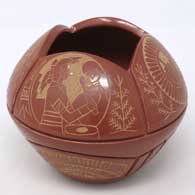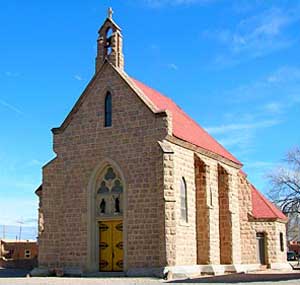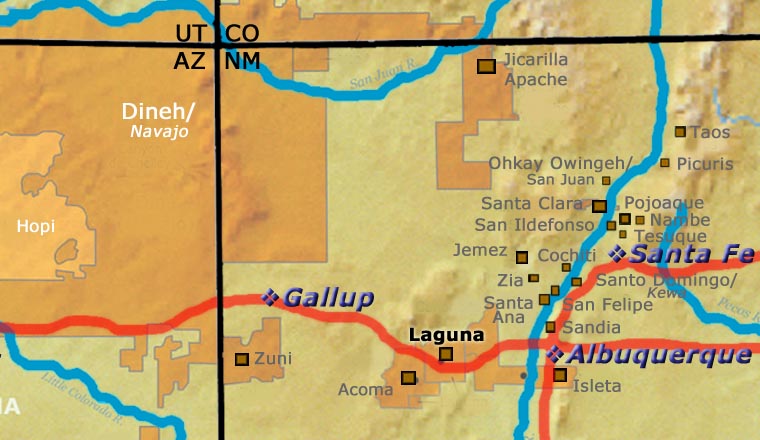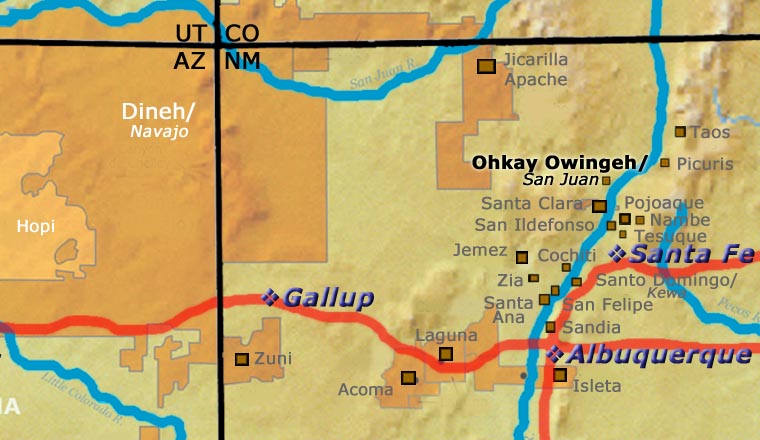
Sue Tapia
Laguna/San Juan

"Each piece of pottery has within it a part of their heart and soul because, traditionally, that's what it takes to work with the gifts that The Mother has so generously provided."
Sue Tapia was born to Edward Poncho Sr. and Mabel Poncho of Laguna Pueblo in May 1946. That was a time when most Laguna men had good-paying jobs and the women were essentially free to do whatever with their time. Mabel had learned to make pottery from her mother and in the early and mid 1950s, often went with her mother to sell pottery along the side of Route 66 as it wound its way across Laguna Pueblo. But Mabel made little pottery for commercial purposes, most of her pottery was for ceremonial use only. That's what Sue learned to make as she was growing up. Then she married Tom Tapia and moved to his home at San Juan Pueblo.
At San Juan, Sue learned to make Potsuwi'i pottery. Tom had grown up learning the traditional methods for making Potsuwi'i pottery with his mother, Leonidas Tapia. Then after marrying Sue, he deviated from that and added sgraffito to his toolkit.
Their process evolved to where Tom designed the pots that Sue made. Then he would decorate some and she would decorate some. They earned many awards over the years at venues like the Gallup InterTribal Ceremonial, the Eight Northern Indian Pueblos Arts & Crafts Show and the New Mexico State Fair.
Tom passed on in 2015 and shortly after, Sue returned to Laguna Pueblo.
100 West San Francisco Street, Santa Fe, New Mexico 87501
(505) 986-1234 - www.andreafisherpottery.com - All Rights Reserved

Laguna Pueblo
After the Pueblo Revolt of 1680, many Puebloans were fearful of Spanish reprisals. Spanish militias returned in 1681 and again in 1689. That first return brought them as far north as Isleta and that pueblo was attacked, looted and burned. The second return saw troops marching up to Santa Ana and San Felipe, attacking, looting and burning both. In those years, when the Puebloans became aware of approaching Spanish forces they mostly scattered into the mountains and the Spanish found empty pueblos, easy to loot and easy to burn. When Don Diego de Vargas marched north in 1692, he was intent on reconquering Nuevo Mexico and re-establishing a long-term Spanish presence there. As the conquistadors who accompanied him were on a "do-or-die" mission, the reconquest took on a tenor quite different from the previous missions...
At first de Vargas followed a path of reconciliation with the pueblos but that was soon replaced with an iron fist that brought on a second revolt in 1696. The pueblos didn't fare so well the second time around and a large number of Pueblo warriors were executed while their wives and children were forced into slavery. When word of de Vargas actions got back to the King of Spain, he ordered de Vargas banned from the New World. However, most of the damage was already done.
Many modern historians say Laguna Pueblo was established between 1697 and 1699 by refugees seeking to avoid fighting with the Spanish. Many of those refugees had left the first pueblos approached by the Spanish in 1692. They had first scattered to more remote places like Acoma, Zuni and Hopi, or to more Spanish-friendly Isleta. However, the pressure of those refugees strained the resources of the other pueblos and quickly forced the refugees to consider starting a new existence in a newly-formed pueblo. The area of Laguna had been settled several hundred years previously by ancestors of today's tribe but had been abandoned during the periods of great drought that had brought the Ancestral Puebloans (Anasazi) down from the Four Corners area to the areas where we now find the Rio Grande Pueblos. Some of the land under Laguna control has also been found to contain archaeological resources dating as far back as 3,000 BC. The prehistoric village of Pottery Mound is located just east of today's Laguna Pueblo boundary. Pottery Mound was abandoned long before the Spanish first arrived but archaeologists have followed the tracks left by Pottery Mound styles, shapes and designs to settlements in the Hopi mesas and the Four Corners area.
Over time, several villages were established in the area around Old Laguna and when the Lagunas were granted their own reservation, they were given about 500,000 acres of land, making Laguna one of the largest of all pueblos in terms of land. However, only about half the enrolled members of the tribe live at Laguna as many have been drawn to nearby Albuquerque in search of work.
Laguna and Acoma share the same language (Western Keresan), similar pottery styles and similar religious beliefs. However, pottery making almost died out at Laguna after the railroads arrived in New Mexico in 1880 and laid a primary east-west trackbed directly in front of the Laguna main pueblo. During that time period many Lagunas went to work on railroad construction crews and many of the traditional Laguna arts and crafts died out. Potterymaking never completely stopped at Laguna but by 1960 it was almost gone. Then in 1973 and again in 1974 Nancy Winslow taught two four-month arts and crafts classes at the pueblo. Among the 22 pueblo members in the first class were Evelyn Cheromiah and her daughters. Rick Dillingham quoted Evelyn Cheromiah as saying that after "looking at my mother's pottery-making tools, I got the urge of going back to making pottery." That was the beginning of today's renaissance in Laguna pottery.
Because of their geographic proximity, Laguna and Acoma clays are very similar. In some instances, it's very hard to determine if a particular pot is from Acoma or from Laguna. Laguna potters are more likely to temper their white clay with sand than with ground up pot shards like the Acomas do. Laguna geometric designs also tend to be bolder than Acoma designs while Laguna potters use Mimbres designs much more sparingly than do Acoma potters.
100 West San Francisco Street, Santa Fe, New Mexico 87501
(505) 986-1234 - www.andreafisherpottery.com - All Rights Reserved

Ohkay Owingeh (San Juan)

Ohkay Owingeh Mission
In 2005 San Juan Pueblo officially changed its name back to the original name (before the Spanish arrived): Ohkay Owingeh (meaning: Place of the strong people). The pueblo was founded around 1200 AD during the time of the great Southwest drought and migrations. The people speak Tewa and may have come to the Rio Grande area from southwestern Colorado or from the San Luis Valley in central Colorado.
Spanish conquistador Don Juan de Oñate took control of the pueblo in 1598, renaming it San Juan de los Caballeros (after his patron saint, John the Baptist). He established the first Spanish capitol of Nuevo Mexico across the Rio Grande in an area he named San Gabriel. In 1608, the capitol was moved south to an uninhabited area that became the Santa Fe we know today.
After 80 years of progressively deteriorating living conditions under the Spanish, the tribe participated in the Pueblo Revolt of 1680 (one of the revolt's ringleaders, Popé, was an Ohkay Owingeh native) and helped to expel the Spanish from Nuevo Mexico for 12 years. However, when the Spanish returned in 1692 that tribal unity had fallen apart and the individual pueblos were relatively easy for the Spanish to reconquer.
Today, Ohkay Owingeh is the largest Tewa-speaking pueblo (in population and land) but few of the younger generations are interested in carrying on with many of the tribe's traditional arts and crafts (such as the making of pottery). The pueblo is home to the Eight Northern Indian Pueblos Council, the Oke-Oweenge Arts Cooperative, the San Juan Lakes Recreation Area and the Ohkay Casino & Resort. The tribe's Tsay Corporation is one of northern New Mexico's largest private employers.
100 West San Francisco Street, Santa Fe, New Mexico 87501
(505) 986-1234 - www.andreafisherpottery.com - All Rights Reserved

Tapia Family Tree
Disclaimer: This "family tree" is a best effort on our part to determine who the potters are in this family and arrange them in a generational order. The general information available is questionable so we have tried to show each of these diagrams to living members of each family to get their input and approval, too. This diagram is subject to change should we get better info.
- Leonidas Cata Tapia (d. 1977) & Joe Blas Tapia
- Tom Tapia (1946-2015) & Sue Tapia (Laguna)(1945-)
- Matt Valencia & Ida Francisco
- Justin Valencia
- Patrick Valencia
- Matt Valencia & Ida Francisco
- Mary Trujillo (1937-2021) & Leonard Trujillo (1936-2017)(Cochiti)(son of Helen Cordero)
Some of the above info is drawn from Pueblo Indian Pottery, 750 Artist Biographies, by Gregory Schaaf, © 2000, Center for Indigenous Arts & Studies
Other info is derived from personal contacts with family members and through interminable searches of the Internet.
(505) 986-1234 - www.andreafisherpottery.com - All Rights Reserved

